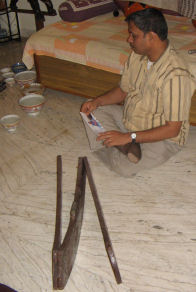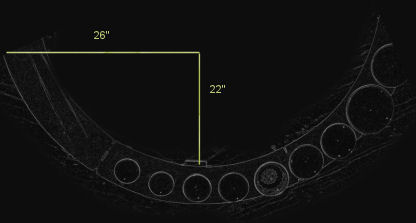Jal-Tarang: Parts and Plate

|
Jal-Tarang: Parts and Plate |
 |
By Ragini Trivedi |
One late afternoon someone rang the door-bell clutching a sheaf of papers,  which I later learned were print-outs of an article on Jaltarang featured on omenad website.
which I later learned were print-outs of an article on Jaltarang featured on omenad website.
Mr. Chetan Solanki had come all the way from Mumbai without any contact address and went from one institution to other till he found someone who could direct him to me. He confessed that he was drawn by my ability to play Jaltarang and hoped that I could help solve some fundamental problems related to this instrument. After we both agreed that it is tough to buy, collect and maintain a set of china-bowls adequate for this instrument, he asked me a question that inspires me to share this information with all future Jaltarang players.
What I jokingly refer to as my pots and pans -- the bowls and its stand, together make the instrument. Of course the bamboo sticks are equally a part of the equipment. The bowls in Jaltarang are of different size and weight. Apart from other minor annoyances, a major cause that mars smoothness of performance is the instability of bowls on the floor. If they are placed on padded cloth mattress they often upturn and spill water; on plain floor they slide away when struck with force as is normal in drut playing. And what happens to them if you are not playing? Believe me the bowls have a tendency to roll and though the sound of china on floor is a melody in itself it spells doom. My father Dr. Lalmani Misra having encountered all these problems had designed a curved wooden stand on which the bowls stand still. As a practising musician, he had to travel often with instruments; being a versatile musician he could be carrying one or more of the instruments he played. Whenever he packed the stand we knew he was off to give a jaltarang presentation. The construction of this stand is given here.
 Three curved wooden slats are joined so that one folds over the other and with hooks attached appropriately lock the three pieces of the plate into a portable pack.
Three curved wooden slats are joined so that one folds over the other and with hooks attached appropriately lock the three pieces of the plate into a portable pack.
Taken as whole the plate is a semicircle of twenty six inches outer radius. It has uniform width of four inches. so when open it measures fifty two inches in straight line from left to right and allows free sitting space to the player of forty four inches at base. 
On the width of plate circular pits are made of one eighth of an inch depth in which the cups fit snugly. A large cup would have proportionately larger base. So the circles on one end of the plate keep reducing in size along the plate. On the final section, number of circles may be six or seven against the five on first section. This depends on the size of bowls. When small bowls are used the need for close placement automatically requires the pits to be made closer. Sometimes two or more bowls may be placed in any given position. Care should be taken to make the largest circle to accommodate biggest of the three.
Another problematic area is the planing inside the pit. Often it is difficult to file or clean inside the small circular pit and often fibres may tip the balance of bowl. The worst nightmare is the safety of the set when it is open. Unless every visitor is warned any slight accident may send your bowls flying. I may seem over-protective to some but it is this anxiety that has made my 57 year old set of Jal-tarang one of the oldest.

Links and References :
Short Video Clip: Hansdhwani on Jal-tarang : Play | Download
Further Reading:
Bharatiya Shastriya Sangeet: Shikshan, Shastra Va Prayog
Jal-Tarang: Tinkle that enchants
Musical inheritence of Dr. Ragini Trivedi
Picasa Album of Learning Jal-tarang with Dr. Ragini Trivedi
For views of musicians on aspects of music click here